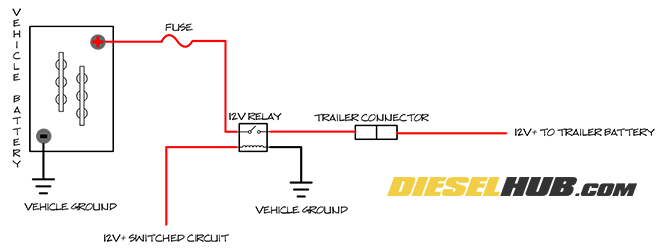Split Charging Battery Isolator Circuits
All that is required to build this circuit is a SPST (single pole, single throw) 12 volt relay, some automotive wire (14 AWG will suffice), and an assortment of terminals. The switched terminals of the relay are spliced into the 12v auxiliary power circuit of the tow vehicle and the coil of the relay is wired to a 12v source on the tow vehicle that is hot only when the key is in the "RUN" position. All vehicles have empty circuits in their fuse box and thus is not particularly difficult to find a power source with a multimeter or probe light. A typical circuit looks something like this:

Split charge circuit wired directly to the vehicle battery
Keep in mind that on a dual battery system (all diesel vehicles) the 12v+ recharge circuit only needs to be connected to ONE positive battery terminal since the batteries are connected in parallel. Alternatively, the auxiliary charge circuit may be wired to the 12v+ output terminal of the alternator (this is common). This is recommended if you are running a new circuit to the trailer plug or are replacing an existing circuit. An example circuit would then be represented in the following figure:

Split charge circuit wired to 12v+ alternator output terminal
We've used a 12 volt, 120 amp marine grade relay. This is extremely overkill for the application but will make for a very reliable system. Our 12v auxiliary power circuit is protected by a 20 amp fuse (fuse size should be based on the wire gauge and length of the circuit). With regard to relay selection, select an automotive/marine relay that reasonable exceeds the amperage rating of the fuse to be used on the circuit. We recommend sourcing a relay that is at least 10 to 20 amps higher than the circuit's fuse rating. This way, a larger fuse could be used on the circuit if ever necessary without needing to replace the relay. The relay you select must be a normally open SPST. A normally closed relay will not allow the trailer to be charged while driving and may drain the batteries when the tow vehicle is off. We recommend one of the following relays for split charging:
Part Number |
Style |
Voltage Rating |
Current Rating (amps) |
SPST, normally open |
12v DC |
120 amps |
|
SPST, normally open |
12v DC |
200 amps |
As previously mentioned, these are somewhat overkill but will make for a reliable split charge circuit and are similarly priced to automotive relays with a much lower amperage rating. They also feature 1/4 inch studs for the switching side of the relay, which makes for a very reliable connection compared to the spade connectors that lower rated relays often use. With regard to fuse size on the charging circuit, refer to the vehicle, trailer, or brake controller manufacturer for recommendations. If in doubt, select a fuse by the ampacity (max amperage rating) of the circuit's smallest wire size.
Note that a numerically higher wire gauge is physically smaller. For example, a 14 AWG (American Wire Gauge) is smaller than a 12 AWG. If the wire at the truck/trailer connector is 12 AWG but the circuit running from the tow vehicle's battery to the connector is only 14 AWG, the size of your fuse must not exceed the maximum amperage rating of the 14 AWG wire. To eliminate confusion, a circuit cannot be protected by a fuse that exceeds the wire's maximum amperage rating. Ampacity ratings vary by wire/insulation type and the length of the circuit.